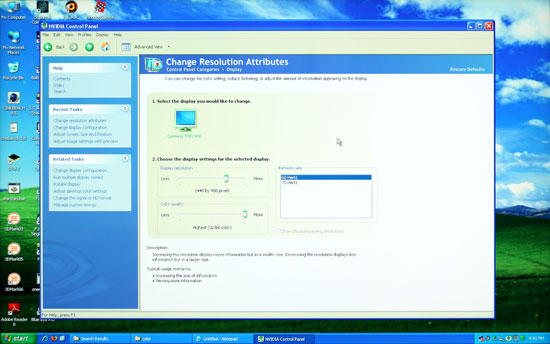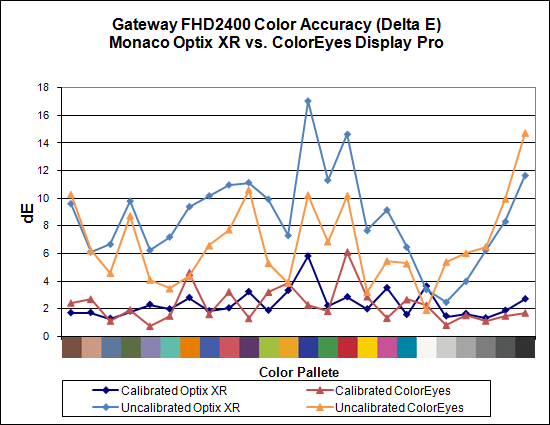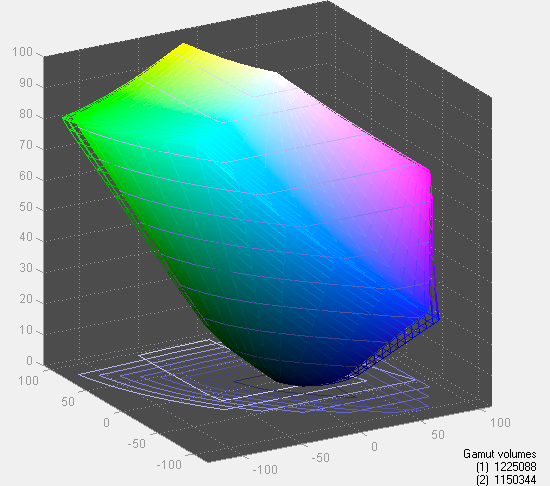Gateway FHD2400 Evaluation
The Gateway OSD remains largely unchanged since last Gateway LCD we reviewed -- the Gateway FPD2485W. It worked well over a year ago and it continues to work well today. Gateway uses a touch-sensitive buttons system on the right side of the LCD, but rather than leaving you to guess where to press, all of the active buttons light up as soon as you press the menu button. Our only complaint is that there are areas where Gateway could make better use of the buttons.
As an example, when you first activate the menu there are six buttons plus an additional two buttons up top that cycle through the color presets. These six buttons allow you to jump directly to one of several areas. Once you enter the Main menu, however, you then have to use the top two buttons to move up and down with the third button functioning as a select key. Granted, there are eight options in the main menu, but two of these (Auto and Reset) could easily be moved to a submenu. As a whole, though, this is a minor complaint on an OSD setup that works well.
Gateway includes seven color presets, one of which is "User" and allows manual adjustment of the color levels. Gateway also includes support for RGB and YUV color spaces. Also of interest is the "UltraResponse" function that supposedly improves pixel response times -- not that we could really tell. Gateway claims 3ms with UltraResponse enabled versus 5ms without UltraResponse.
The FHD2400 has four aspect ratio options: Wide, Zoom, 1:1, and Panoramic. "Panoramic" scaling only shows up with component (and perhaps other analog video connections), but then it just seems to do the same thing as "Wide". "Wide" fills the entire LCD with your current resolution, while "Zoom" fills the height or width while maintaining the correct aspect ratio. "1:1" is again a direct-mapped mode without any stretching. Here's a summary of our resolution testing:
| Gateway FHD2400 Resolution and Input Notes | ||||
| Component | DVI | HDMI | VGA | |
| 800x600 | Yes | Yes | Yes | |
| 1024x768 | Yes | Yes | Yes | |
| 1152x864 | Yes | Yes | Yes | |
| 1176x664 | Underscanned 720P | - | Underscanned 720P | - |
| 1280x720 | Yes | Yes | Yes | Yes |
| 1280x768 | Yes | Wrong AR (1280x1024) Use "Zoom" scaling |
Yes | |
| 1280x800 | - | Wrong AR (1280x1024) Use "Zoom" scaling |
- | |
| 1280x960 | Yes | Yes | Yes | |
| 1280x1024 | Yes | Yes | Yes | |
| 1400x1050 | - | Yes | - | |
| 1440x900 | Yes | Yes | Yes | |
| 1600x1200 | Yes | Wrong AR Always fills LCD ("Zoom") |
Yes | |
| 1680x1050 | Yes | Yes | Yes | |
| 1768x992 | Underscanned 1080i | - | Underscanned 1080P | - |
| 1920x1080 | Too much flicker | Yes | Yes | Yes |
| 1920x1200 | - | Yes | Yes | Yes |
First, let's get this out of the way: the component connection is only really suitable for 720P or 1080i signals. In general, the 720P option looks much better -- the opposite of the 2408WFP when using a component connection. All resolutions with more than 720 scanlines show severe flicker on component, as they run 60Hz interlaced. The other tested input options all work much better. VGA and DVI achieve a perfect score on all of the available resolutions, with no scaling abnormalities. Also worth mentioning is that the "Auto adjust" function on VGA is very fast. HDMI input has a few errors that you can work around by manually selecting "Wide" scaling; only 1600x1200 as an uncorrectable error in that it always fills the entire LCD, regardless of what scaling mode you choose.
 |
Running at non-native resolution, the FHD2400 does well at scaling the image to fit the panel and there are no serious artifacts. Obviously, 1920x1200 is still the optimal setting, but if you need to play a game or watch a movie at a lower resolution, you shouldn't have any complaints.


Besides limited viewing angles -- which are a problem on all TN panels today -- the one sticking point with the Gateway FHD2400 is color accuracy. After calibration, it achieves an average Delta E of only 2.3, which puts it in last place among tested LCDs. Uncalibrated color accuracy is also quite poor, coming in at 8.6 with plenty of colors above 10.0. Imaging professionals will almost certainly want something better. The good news is that the color gamut is good, achieving over 95% of the Adobe RGB 1998 standard.
The Gateway FHD2400 is sort of the opposite of the Dell 2408WFP. The Dell offers the absolute worst input lag but has by far and away the best color accuracy. The FHD2400 doesn't suffer from input lag at all, but unfortunately it has some of the worst color accuracy among tested LCDs. It's still a beautiful looking LCD, and it gets so many things right that we have no qualms recommending it to non-imaging professionals. That goes double if you'd like glossy LCD panels.
















89 Comments
View All Comments
Dainas - Friday, May 2, 2008 - link
Well, it would not be as much fun as if they had done it 3 months ago. All the sub-$500 'jewels' have been dissapearing from the market. Just as well though, might as well review something that will still be easy to buy +6 months down the road.JarredWalton - Friday, May 2, 2008 - link
It shouldn't be too much of a surprise that the cheapest LCDs often have much lower quality. That being the case, most of the manufacturers of cheap LCDs are unwilling to send us review units. Hence, we end up with 24" roundups (and some upcoming 27 and 30" units as well).That said, I think more people should bite the bullet and splurge on a really nice display. I couldn't imagine running an SLI or CrossFire system without at least a 24" monitor, and having upgraded to a 30" LCD 18 months back I've never regretted the decision. I hope to continue to use my 30" LCD for at least another 5 years; try saying that about the rest of a PC. $500 sounds like a lot, but a good display can last through several PC upgrades.
Basilisk - Friday, May 2, 2008 - link
I have to agree with the original poster on this sub-thread. There's nothing about these four units that command my interest yet. If you're not shipped the units, I still find it surprising that you don't know folks who've bought the cheaper units -- I do -- or a store manager who might loan them. Whatever, you have your criteria, even if they edge your review towards irrelevance for me."That said, I think more people should bite the bullet and splurge on a really nice display." Well... that's been my strategy in life, but I've now retired and the economic picture has changed; others haven't the coins to spare or a need that justifies the extra bucks. I game, but nothing requiring high speed LCDs; I work with pictures, but nothing that justifies full color gamut monitors. So... what is there beyond elitism to recommend spending an extra $200-$400 for something I won't use? Some might call that an immature purchase decision, not splurging. I'd have loved to see the OfficeMax Soyo 24" monitor -- recurringly sold at $275 -- included so I'd know why NOT to buy it, or to.
Well, I'll probably skip the 24" size and make a 28" my next purchase anyway: at my age, size matters. :) The old orbs are becoming challenged using my 21" CRT and 22" WS LCD on detailed web pages.
strikeback03 - Tuesday, May 6, 2008 - link
For our lab we have bought a few of the Westinghouse 24" monitors Newegg sells for ~350 (After rebate) and for the price I'd assume they use a TN panel, but it has very good viewing angles.http://img.photobucket.com/albums/v315/strikeback0...">http://img.photobucket.com/albums/v315/strikeback0...
Have not had a chance to try color calibration. Seems it's biggest problems are 1) no DVI, and over HDMI it goes to blue screen instead of sleep when the signal is cut; and 2) the controls for the OSD are awful, they are on the side of the monitor so you have to try and look at their tiny labels and look around at the screen to do anything.
Dainas - Thursday, May 1, 2008 - link
Well its partly bullshit, there is a lolair MVA (different take on PVA) that has zero input lag and is lighting fast even among TNs.I can assure you of one thing, the lag in the PVA 2408WFP and LaCie is however definitely not due to the panel. Just as the 3008WFP IPS is as slow as mud next to the 3007WFP IPS due to its built in scalar. But Dell panels were never fast and I'm sure a PVA could be made as fast as the fastest MVAs, which are as fast as TNs as any sane gamer could be concerned.
Dainas - Thursday, May 1, 2008 - link
No edit function, ugh.JarredWalton - Friday, May 2, 2008 - link
I'm not at all sure that PVA can be made as fast as TN. If it can, then why do the Gateway LCDs behave so differently? The interface is practically the same and they both use Faroudja video processors. Why would Gateway use one scaler on their S-PVA and a different one on the TN - particularly if the TN scaler appears better?I don't doubt that they can reduce the lag, but you'll notice out of nine LCDs five have lag of 18ms or more and four have virtually no lag; the four without lag are TN and the five with lag are S-PVA. The circumstantial evidence is pretty significant.
Pirks - Thursday, May 1, 2008 - link
http://www.newegg.com/Product/Product.aspx?Item=N8...">http://www.newegg.com/Product/Product.aspx?Item=N8...Dying to see this reviewed!
Puhleeeasseee with sugar on top
Okay? :D
timmiser - Monday, May 5, 2008 - link
This is my monitor I've been using for the past 6 months and I absolutely love it. I bought mine at Costco.com for the same price that most of those 24" were selling for at the time. One thing about is the fact that is has the same resolution as the 24" screens so everything is a bit larger but to me, that is a good thing. I had one 19" Hanns-G monitor prior to this and can agree on the cheapness but this one I feel is of very high quality and no complaints yet.Googer - Friday, May 2, 2008 - link
I have read multiple HANS-G monitor reviews from other hardware sites in the past and the consensus is that HANS-G monitors are cheaply made to match the cheap price tag, typically resulting in a poor review.